
Chris "Coz" Costello
Senior Director of Marketing Research @ Skai

Chris "Coz" Costello
Senior Director of Marketing Research @ Skai

In its most recent quarterly earnings report, you may have noticed something slightly different in how Amazon broke out its quarterly revenues. For the first time, Amazon’s advertising numbers and revenue were given their line item and not just lumped into the “other” category.
Now we can say, with more certainty, that ad revenue grew by 32% rather than torturing the English language with other revenue, a category that is presumed to be dominated by advertising, was up by 32%.
Copy editors everywhere, rejoice!
With more clarity around Amazon’s advertising numbers—and with that same spirit of sharing—we thought this was a good opportunity to expand on the retail media analysis found in the Skai Quarterly Trends Report and share some of the trends that didn’t make it in this time around.
Retail media experts know that there are differences between the two primary ad types in the Amazon ecosystem across both the website and the Amazon app: Sponsored Products ads and Sponsored Brands ads (which include Sponsored Brands video ads). But how do they differ?
The following analysis uses billable spending on the Skai platform in the US Amazon Marketplace. Data is filtered the same way as our Quarterly Trends Report—15 months of consecutive channel spending at the account level.
On the front end, Sponsored Brand ads have been consistently more expensive than Sponsored Products and the gap has gotten wider over time. Sponsored Brand ads also showed more inflation heading from Q3 to Q4.
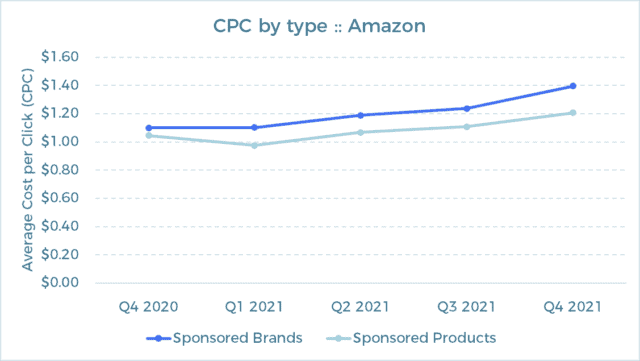
At a high level, clickthrough rates for retail media ads are typically low compared to, for example, paid search ads. However, Sponsored Brand ads have shown more variation within that narrow band of engagement over time, and saw CTR increase from Q3 to Q4 while Sponsored Product ads behaved more like product-level ads in other channels, where impressions typically grow at a faster rate than clicks, resulting in lower CTR during the high-intensity period.
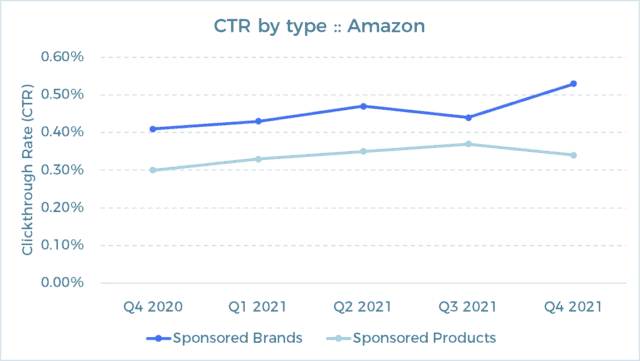
If we turn to conversion-based metrics, we first see that Sponsored Product ads have converted at a higher rate than Sponsored Brand ads over the entirety of the last five quarters, and that gap has gotten somewhat larger through the back half of 2021.
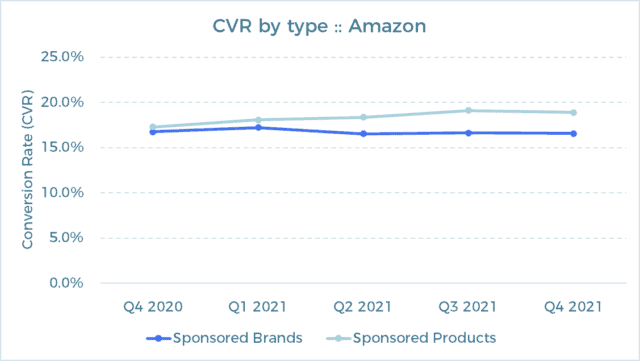
However, conversion rate alone does not fully describe the effectiveness of retail media advertising. If we balance that against program costs, by looking at the average cost per action (CPA), we see the inevitable result of higher click prices and lower conversion rates, which is to say that the acquisition cost for Sponsored Brands is higher than that of Sponsored Products, with a gap of over one dollar in Q4 2021.
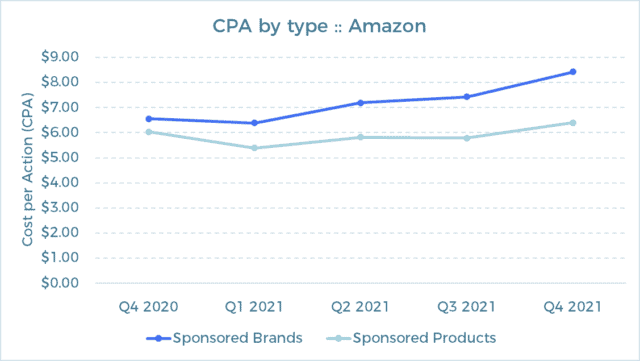
Finally, if we take the transaction value into account, we can measure the Return on Ad Spend (ROAS) for our two different ad types. Here, the gap between Sponsored Brand and Sponsored Product ads is smaller, and Sponsored Brand ads showed an advantage in ROAS in Q4 of both this year and last year. This is likely due to changes in average order size that reflect holiday shopping behavior and the influence that broader messaging can have on that behavior.
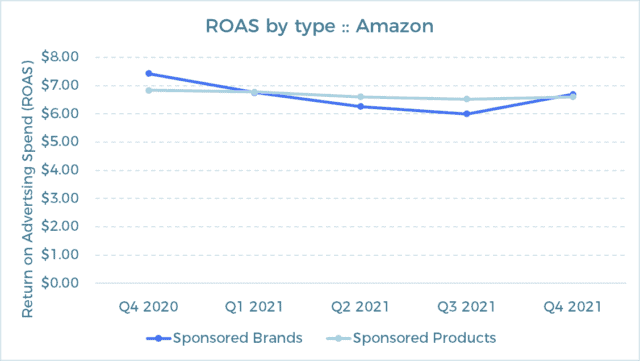
We hope that this deep dive into Amazon ad behavior helps you put your own program into greater context.
Check back on the blog for more analysis and insights!
As part of Skai’s intelligent marketing platform, our Retail Media solution empowers brands to plan, execute, and measure digital campaigns that meet consumers when and where they shop. Built with best-in-class automation and optimization capabilities, our unified platform allows you to manage campaigns on 30+ retailers including Amazon, Walmart, Target, and Instacart all in one place.
Contact us today to set up a brief demo to see all of our cutting-edge features for yourself.
We use cookies on our website. Some of them are essential, while others help us to improve this website and your experience.
Here you will find an overview of all cookies used. You can give your consent to whole categories or display further information and select certain cookies.